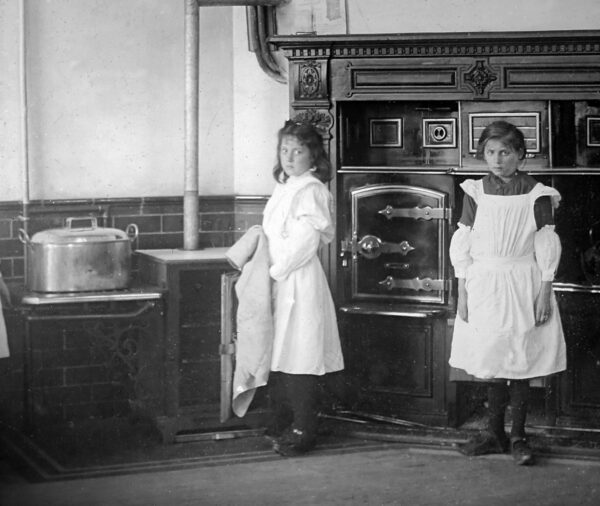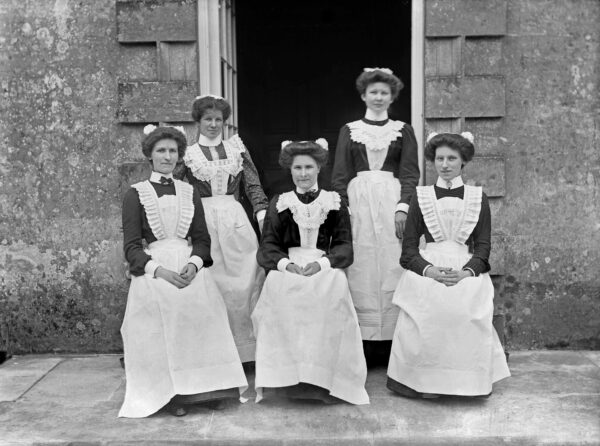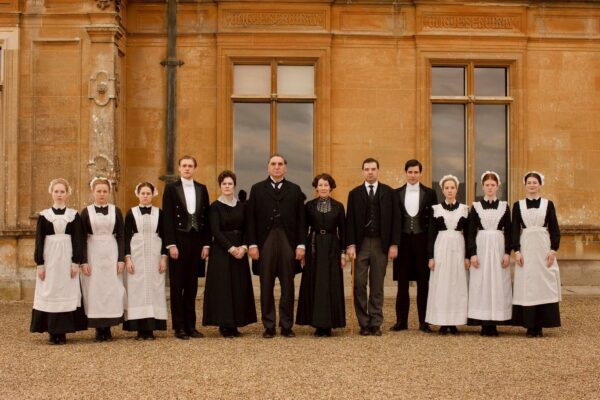What ‘Downton Abbey’ doesn’t show you: The dark side of life as a servant in Britain’s mansions – by RAQUEL VIDALES

Two girls pose in the kitchen of the house where they worked as maids, in an image dated to the Victorian era. KGPA LTD / ALAMY STOCK PHOTO
Source:english.elpais.com
In 1879, shortly after starting work at the age of 10 as a servant in a mansion in a suburb of London, Harriet Brown wrote in a letter to her mother: “I am up at half-past five and six every morning and do not go to bed till nearly 12 at night and I feel so tired sometimes I am obliged to have a good cry. I do think I should have been laid up if it was not for the Cod Liver Oil I am taking.” Two decades later, history would repeat itself with her daughter Ellen, who at the same age became the eighth of eight maids in another house in the British capital. As a newcomer, she had the toughest tasks. She had to scrub bare-boarded floors with a mixture of soft soap and silver sand that left her hands and forearms raw. Most nights she cried herself to sleep.
The story of Harriet and Ellen appears in the book Not in Front of the Servants: A True Portrait of Upstairs, Downstairs Life by Frank Victor Dawes, a late British journalist who in 1972 published an advertisement in The Daily Telegraph in which he asked people who had worked as servants to send him letters recounting their experiences. The Spanish publishing house Periférico has published it for the first time in Spanish with a translation by Ángeles de los Santos. Its launch coincides with the premiere of Downton Abbey: A New Era, a new movie based on the popular TV show Downton Abbey. This British historical drama, which first aired in 2010, paints an idyllic picture of the life of a Victorian family and their servants, in line with its predecessor, the 1970s TV show Upstairs, Downstairs. Neither TV show offers a glimpse of the suffering of servants, as reflected in the testimonies in Dawes’s book. Everything seems to be where it should be, both objects and people: everyone happy in their rightful place.
This image is far from the experience of Elizabeth Simpson, born in 1853, who also began working as a maid at the age of 10 in a mansion in the county of Yorkshire. As her granddaughter told Dawes, she had to get up at 4am to scrub the stone floors of the dairy with cold water and churn butter until her arms ached. At those early hours, she worked by the light of a single candle which she pushed ahead of her as she moved across the stone flags on her knees. She was kept working all day. Under the rules of the mansion, which were strictly enforced, she was never to be seen by any of the family. If, by some mischance, they happened to meet, she was not to talk to them, but curtsey and disappear as quickly as possible.
When he published that advertisement, Dawes intended to tell the true story of domestic workers in the United Kingdom – from the peak of the sector in the mid-nineteenth century to its progressive decline after World War I. Dawes, who was the son of a maid who began to serve at the age of 13, wanted to investigate the reasons for this drop: until the beginning of the First World War, close to 1.5 million women and girls were employed as indoor servants, a number that dropped to 100,000 in the 1970s. He received nearly 700 letters in the space a few months, and these served as the basis for his book, which became a best-seller when it was published in 1973, at the height of interest over Upstairs, Downstairs.

Servants at Biddlesden Park House, Buckinghamshire, in a photo taken between 1896 and1920. ALFRED NEWTON & SONS (HISTORIC ENGLAND ARCHIVE/HERITAGE)
From the first pages of the book, it is clear that the servants of Victorian houses lived in conditions close to slavery. They barely had a few free hours a week, they could be fired on a whim and they slept in terrible conditions. Violet Turner, who worked in a boarding house shortly before World War I, recalls having to sleep in the bathroom on a folding bed: “When I got up in the morning I had to fold my bed up and put it on the landing in time for the ‘paying guests’ to have their bath.”
And worst of all, both servant and master were fed the idea that their position in life responded to divine order. “The Bible was used to convince them to recognize the superiority of those they served,” explains Dawes. Bible passages such as this one from the Epistle to the Ephesians reached servants from the pulpits: “Servants, be obedient to them that are your masters according to the flesh, with fear and trembling, in singleness of your heart, as unto Christ.” Religion was used to ensure submission to the system.

The servants from the TV show ‘Downton Abbey.’
The masters, for their part, lived with a clear conscience because socially the servants were considered “different” beings, if not “inferior.” That helped to morally justify child exploitation and sexual abuse. “As for the servants and women of lower classes […] they all fornicated in secret and were proud to have a gentleman to cover them. That was the opinion of men of my lifestyle and my age,” recounts a Victorian gentleman in his memoirs, which he published anonymously in 1890 under the title My Secret Life. “If, as happened all too often, a servant girl became pregnant by one of the family, the blame was placed squarely on her shoulders, not his,” writes Dawes. Often these women were fired without a reference, which left her the alternative of the workhouse or prostitution.
This idea that servants were “inferior” also explains why the trade union movement for better rights ignored them until well into the 20th century. And it helps explain why servants were met with greater resistance when they attempted to organize. “I regard any possibility of the introduction into the conditions of domestic service of the type of relations now obtainable between employers and workers in industrial life as extremely undesirable and liable to react in a disastrous manner on the whole foundation of home life,” the Marchioness of Londonderry wrote in a letter in the 1920s. It took another decade for servants’ demands for minimum wages and free time to be recognized, in part because the need for female labor in factories during World War I meant that many women discovered that they could access better jobs. The salaries might not have been better, but at least the women weren’t treated like slaves. And the shortage of maids began to be a real problem in the country.
It was the beginning of the end of the golden age of servants in the UK. And also the end of a way of life in which the social position of a family was measured by the number of servants they had.
But certain stigmas about domestic work persist not only in the UK, but throughout the world. “‘Maid’ is a dainty word, redolent of tea trays, starched uniforms, Downton Abbey. But in reality, the maid’s world is encrusted with grime and shit stains. These workers unclog our drains of pubic hairs, they witness our dirty laundry literally and metaphorically. Yet, they remain invisible,” writes American activist Barbara Ehrenreich in the prologue to the best-selling book Maid, in which Stephanie Land recounts her years working as a cleaner while looking after a young daughter in charge.
Meanwhile, last Friday, an 86-year-old woman in Brazil was rescued from a house in Rio de Janeiro, where she had been enslaved for seven decades. The woman had worked for three generations of a family without ever receiving a salary or having time off. When they found her, she was sleeping on a sofa at the door of her master’s room, who was also in her eighties.







